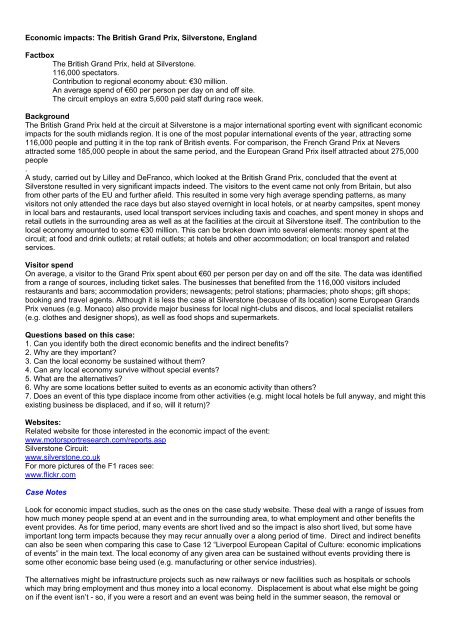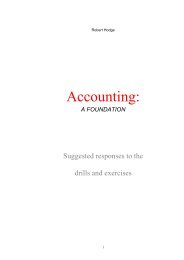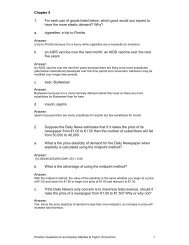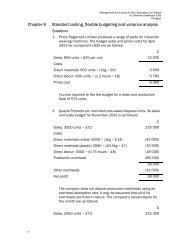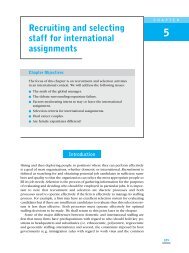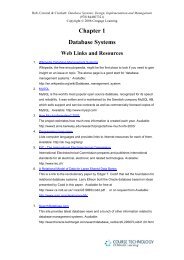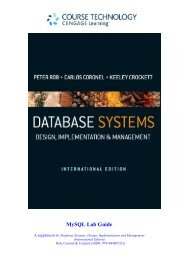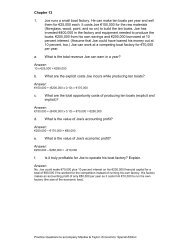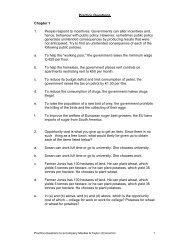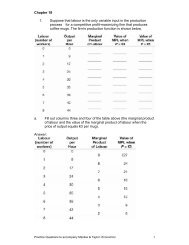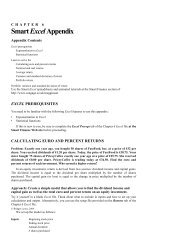Economic impacts: The British Grand Prix, Silverstone, England
Economic impacts: The British Grand Prix, Silverstone, England
Economic impacts: The British Grand Prix, Silverstone, England
Create successful ePaper yourself
Turn your PDF publications into a flip-book with our unique Google optimized e-Paper software.
<strong>Economic</strong> <strong>impacts</strong>: <strong>The</strong> <strong>British</strong> <strong>Grand</strong> <strong>Prix</strong>, <strong>Silverstone</strong>, <strong>England</strong>Factbox<strong>The</strong> <strong>British</strong> <strong>Grand</strong> <strong>Prix</strong>, held at <strong>Silverstone</strong>.116,000 spectators.Contribution to regional economy about: €30 million.An average spend of €60 per person per day on and off site.<strong>The</strong> circuit employs an extra 5,600 paid staff during race week.Background<strong>The</strong> <strong>British</strong> <strong>Grand</strong> <strong>Prix</strong> held at the circuit at <strong>Silverstone</strong> is a major international sporting event with significant economic<strong>impacts</strong> for the south midlands region. It is one of the most popular international events of the year, attracting some116,000 people and putting it in the top rank of <strong>British</strong> events. For comparison, the French <strong>Grand</strong> <strong>Prix</strong> at Neversattracted some 185,000 people in about the same period, and the European <strong>Grand</strong> <strong>Prix</strong> itself attracted about 275,000people.A study, carried out by Lilley and DeFranco, which looked at the <strong>British</strong> <strong>Grand</strong> <strong>Prix</strong>, concluded that the event at<strong>Silverstone</strong> resulted in very significant <strong>impacts</strong> indeed. <strong>The</strong> visitors to the event came not only from Britain, but alsofrom other parts of the EU and further afield. This resulted in some very high average spending patterns, as manyvisitors not only attended the race days but also stayed overnight in local hotels, or at nearby campsites, spent moneyin local bars and restaurants, used local transport services including taxis and coaches, and spent money in shops andretail outlets in the surrounding area as well as at the facilities at the circuit at <strong>Silverstone</strong> itself. <strong>The</strong> contribution to thelocal economy amounted to some €30 million. This can be broken down into several elements: money spent at thecircuit; at food and drink outlets; at retail outlets; at hotels and other accommodation; on local transport and relatedservices.Visitor spendOn average, a visitor to the <strong>Grand</strong> <strong>Prix</strong> spent about €60 per person per day on and off the site. <strong>The</strong> data was identifiedfrom a range of sources, including ticket sales. <strong>The</strong> businesses that benefited from the 116,000 visitors includedrestaurants and bars; accommodation providers; newsagents; petrol stations; pharmacies; photo shops; gift shops;booking and travel agents. Although it is less the case at <strong>Silverstone</strong> (because of its location) some European <strong>Grand</strong>s<strong>Prix</strong> venues (e.g. Monaco) also provide major business for local night-clubs and discos, and local specialist retailers(e.g. clothes and designer shops), as well as food shops and supermarkets.Questions based on this case:1. Can you identify both the direct economic benefits and the indirect benefits?2. Why are they important?3. Can the local economy be sustained without them?4. Can any local economy survive without special events?5. What are the alternatives?6. Why are some locations better suited to events as an economic activity than others?7. Does an event of this type displace income from other activities (e.g. might local hotels be full anyway, and might thisexisting business be displaced, and if so, will it return)?Websites:Related website for those interested in the economic impact of the event:www.motorsportresearch.com/reports.asp<strong>Silverstone</strong> Circuit:www.silverstone.co.ukFor more pictures of the F1 races see:www.flickr.comCase NotesLook for economic impact studies, such as the ones on the case study website. <strong>The</strong>se deal with a range of issues fromhow much money people spend at an event and in the surrounding area, to what employment and other benefits theevent provides. As for time period, many events are short lived and so the impact is also short lived, but some haveimportant long term <strong>impacts</strong> because they may recur annually over a along period of time. Direct and indirect benefitscan also be seen when comparing this case to Case 12 “Liverpool European Capital of Culture: economic implicationsof events” in the main text. <strong>The</strong> local economy of any given area can be sustained without events providing there issome other economic base being used (e.g. manufacturing or other service industries).<strong>The</strong> alternatives might be infrastructure projects such as new railways or new facilities such as hospitals or schoolswhich may bring employment and thus money into a local economy. Displacement is about what else might be goingon if the event isn’t - so, if you were a resort and an event was being held in the summer season, the removal or
closure of the event might not impact too badly if other seasonal demand (for example tourism) takes up the vacatedspace or facilities. On the other hand, if there is little to fill the gap of a big event not taking place, then this might have aserious effect on the economy of a smaller town or resort.See also, the EventIMPACT online resource, of UK Sport: http://www.event<strong>impacts</strong>.com/


